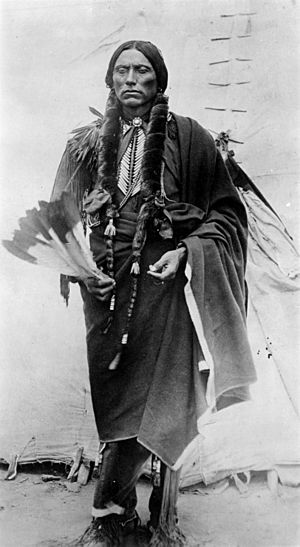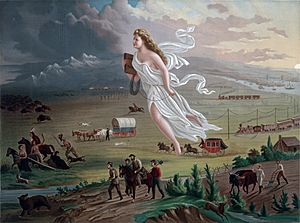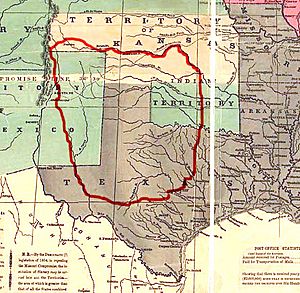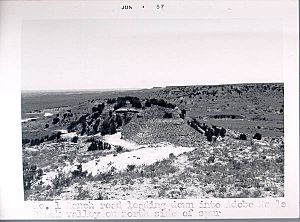Comanche campaign facts for kids
Quick facts for kids Comanche campaign |
|||||||
|---|---|---|---|---|---|---|---|
|
|||||||
| Belligerents | |||||||
| Comanche | |||||||
| Commanders and leaders | |||||||
| Quanah Parker | |||||||
The Comanche campaign was a series of military actions by the United States government. These actions were against the Comanche tribe in the western parts of the country. From 1867 to 1875, soldiers fought against the Comanche people. These fights continued until the Comanche surrendered and moved to a special area called a reservation.
Contents
Why Did the Comanche Campaign Happen?
As settlers from Spain, France, England, and America moved west, they met the native tribes. Some tribes were friendly and traded with the newcomers. Other tribes did not want the settlers on their land.
The idea of Manifest Destiny made many Americans believe it was their right to expand across the continent. The Homestead Act also encouraged people to move west. This led to more competition for land. This competition caused problems between the settlers and Native Americans.
Many treaties were signed to promise land and peace. But these treaties were often broken. The Comanche tribe was a strong group that resisted the new settlers. They often fought with both other tribes and the newcomers in what is now Oklahoma and Texas.
During the American Civil War, some Native American tribes sided with the Confederacy. The Comanche signed a treaty with the Confederacy. When the war ended, they had to promise loyalty to the U.S. government. This did not stop the fighting in the region.
The Comanche controlled a large area of the southern plains called the Comancheria. They worked hard to keep their power there. In 1865, the Treaty of Little Arkansas gave the Comanche a large piece of land. This land was in Oklahoma and Texas.
Some parts of the Comancheria soon became part of the Indian reservation system. The Medicine Lodge Treaty in 1867 helped set up these reservations for the Plains Indians. These policies were part of President Ulysses S. Grant's Peace Policy. This policy focused on helping Native Americans through missionary work and education, rather than fighting.
What Was the Comanche Campaign?
One group of the Comanche tribe, called the Quahadi, strongly resisted the settlers. They did not trust the newcomers and avoided contact. They did not trade with the settlers. Because of this, they were not affected by diseases like cholera in 1816 and 1849.
The Quahadi were known for being fierce. Even other Comanche tribes feared them. They were the richest Comanche group, owning many horses and cattle. They had never signed a peace treaty. This group caused the most trouble for the American troops.

General William T. Sherman sent four cavalry companies from the U.S. Army. Their first goal was to capture those responsible for the Warren Wagon raid. But this mission soon grew into trying to stop the threat from the Comanche tribe, especially Quanah Parker and his Quahadi group.
After the Civil War, the Army had few soldiers and little money. So, only a small number of men were sent west. About 5,000 soldiers, divided into ten regiments, faced the powerful Comanche. General Sherman chose Ranald S. Mackenzie to lead the attack. President Grant called Mackenzie "the most promising young officer in the army." Mackenzie commanded the 4th Cavalry.
Mackenzie and his men developed a new way of fighting. Instead of big battles, they aimed to slowly weaken the Comanche. Colonel Mackenzie went on several trips into the Comancheria. He wanted to destroy the Comanche's winter camps, crops, horses, and cattle. This was similar to General Sherman's "March to the Sea" during the Civil War. The 4th Cavalry fought the Comanche by destroying their way of life.
Fighting in Llano Estacado
In the fall of 1871, Mackenzie and his 4th Cavalry arrived in Texas. Two companies from the 11th Infantry joined them. They began looking for the Comanche. The campaign started in the Llano Estacado region. This was where Comanche were thought to be camping.
In his first trip, Mackenzie and his men attacked these camps twice. The campaign began with the Battle of Blanco Canyon. With the help of Tonkawa scouts, Mackenzie found Quanah Parker's group. They also saved another group of American soldiers. They pushed the Quahadi deep into the region. But they had to stop the hunt for the winter.
The second trip lasted longer, from September to November. It showed the Comanche that the peace policy was no longer fully in effect. Mackenzie set up strong patrols at forts like Fort Richardson, Fort Griffin, and Fort Concho. There were not many direct battles. However, the American tactics worked. By following the Comanche and destroying their camps, Mackenzie's cavalry made it hard for them to prepare for winter.
Mackenzie's third trip in September 1872 was the largest. He captured 130 Comanche women and children. His troops also stole horses and raided Indian camps. Mackenzie and the Fourth Cavalry covered the region many times. They had help from the Twenty-fourth Infantry and his Tonkawa scouts.
These captives were later used in a deal at Fort Sill. The soldiers offered peace in exchange for the hostages. The Comanche agreed, and there was a time of peace.
During this peaceful time, Mackenzie continued to explore the Llano Estacado region. He also created a second front in the west. This was to cut off the Comanche from their weapons and food. In the winter of 1873, many Comanche people stayed at Fort Sill. After the hostage exchange, there was less violence.
However, to make the Comanche fully surrender, there was a push for bison hunting. The bison population became very low. Those Comanche not at Fort Sill faced starvation. The remaining Native American tribes gathered at the North Fork of the Red River. This was the center of the shrinking Comancheria. Tensions grew with the Indian Office. The Indians saw the withholding of food as a declaration of war. They reacted accordingly.
The Red River War
The Second Battle of Adobe Walls in 1874 was an early fight in the summer and fall campaign. It did not involve military soldiers directly. After this attack, government officials ordered all Southern Plains Indians to be on their reservations by August 1, 1874.
After the deadline, about 2,000 Comanche were still in the Comancheria. When they refused to move, the U.S. government sent 1,400 soldiers. This operation became known as the Red River War.
One important battle of the Red River War was at Palo Duro Canyon. This happened on September 28, 1874. Colonel Mackenzie, with his Black Seminole Scouts and Tonkawa scouts, surprised the Comanche and other tribes. They destroyed their camps. Only three Comanche were killed in the battle. But their camp and all their horses were destroyed. This defeat marked the end of the war between the Comanche and the Americans.
What Happened After the Campaign?
After the Red River War, which lasted from August to November 1874, the Comanche surrendered. They moved to their new lands on the reservation. However, even after this loss, the last of the Comanche did not surrender until June 1875. These were the Comanche led by Quanah Parker, who finally surrendered at Fort Sill.
The U.S. troops directly caused only a few hundred deaths. But their tactics in the Comanche campaign were very damaging to the tribe. These tactics led to the economic downfall of the tribe, not just military defeat. In 1870, there were nearly 5,000 Comanche people. By 1875, when they finally surrendered and moved to the reservation, only about 1,500 remained.




